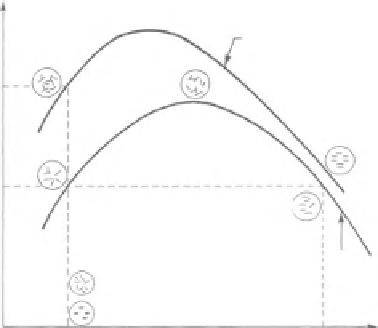Environmental Engineering Reference
In-Depth Information
where:
High compactive
effort
τ
ff
=
shear stress on the failure plane at failure,
c
=
effective cohesion, which is the shear
strength intercept when effective normal
stress is equal to zero,
B
(σ
f
−
u
w
)
f
=
effective normal stress on the failure plane
at failure,
C
A
σ
ff
=
total normal stress on the failure plane at
failure,
Soils
A
≠
B
≠
C
u
wf
=
pore-water pressure at failure, and
Low
compactive
effort
= flocculated soil structure
φ
=
effective angle of internal friction.
= dispersed soil structure
Equation 11.1 defines a linear relationship between shear
strength and effective stresses as illustrated in Fig. 11.2. The
line tangent to the Mohr circles is commonly referred to as a
failure envelope since it represents possible combinations of
shear stress and effective normal stress on the failure plane
at failure. The shear and normal stresses are given the sub-
script
f
.The
f
subscript within the parentheses refers to the
failure plane, and the
f
subscript outside of the parenthe-
ses indicates the failure stress condition. One subscript
f
is
given to the pore-water pressure when referring to failure
conditions. The pore-water pressure is isotropic and there-
fore acts equally on all planes. The shear stress described
by the failure envelope indicates the shear strength of the
soil for each effective normal stress.
The failure envelope for a saturated soil is obtained by
plotting a line tangent to a series of Mohr circles represent-
ing the stress state at failure. The slope of the line defines the
effective angle of internal friction,
φ
, and its intercept on
the ordinate is called the effective cohesion,
c
. The direc-
tion of the failure plane in the soil is obtained by joining the
pole point to the point of tangency between the Mohr circle
and the failure envelope. The tangent point on the Mohr cir-
cle at failure represents the stress state on the failure plane
at failure.
Water content,
w
Figure 11.1
Particle structure or fabric of clay specimens com-
pacted at various dry densities and water contents (after Lambe,
1958).
a brief review of the Mohr-Coulomb failure criteria (Mohr,
1914) for a saturated soil. Other failure criteria such as the
Tresca (1868) criterion and the von Mises (1913) criterion
could also be extended to consider unsaturated soil behav-
ior; however, these extensions have not been included in
this topic. Rather, the presentation will be limited to exten-
sions to the Mohr-Coulomb failure conditions for unsatu-
rated soils. The extensions to the Mohr-Coulomb criterion
are referred to as the “extended Mohr-Coulomb” failure cri-
terion for unsaturated soil.
11.2.1 Shear Strength of Saturated Soil
The shear strength of a
saturated
soil can be described using
the Mohr-Coulomb failure criterion and the effective stress
variable (Terzaghi, 1936):
c
+
σ
f
−
u
w
f
tan
φ
τ
ff
=
(11.1)
Failure envelope:
τ
ff
=
c
′
+ (
σ
f
-
u
w
)
f
tan
φ
′
φ
′
σ
ff
= total normal stress on the failure
plane at failure
φ
′
= effective angle of internal friction
c
′
= effective cohesion which is the shear
strength intercept when the effective
normal stress is equal to zero
c
′
Effective normal stress,
σ
f
-
u
w
Figure 11.2
Mohr-Coulomb failure envelope for saturated soil.












Search WWH ::

Custom Search